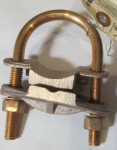250.70 Methods of Grounding and Bonding Conductor Connection to Electrodes. The grounding or bonding conductor shall be connected to the grounding electrode by exothermic welding, listed lugs, listed pressure connectors, listed clamps, or other listed means. Connections depending on solder shall not be used. Ground clamps shall be listed for the materials of the grounding electrode and the grounding electrode conductor and, where used on pipe, rod, or other buried electrodes, shall also be listed for direct soil burial or concrete encasement. Not more than one conductor shall be connected to the grounding electrode by a single clamp or fitting unless the clamp or fitting is listed for multiple conductors. One of the following methods shall be used:
(1) A pipe fitting, pipe plug, or other approved device screwed into a pipe or pipe fitting
(2) A listed bolted clamp of cast bronze or brass, or plain or malleable iron
(3) For indoor communications purposes only, a listed sheet metal strap-type ground clamp having a rigid metal base
that seats on the electrode and having a strap of such material and dimensions that it is not likely to stretch during or after installation
(4) An equally substantial approved means



